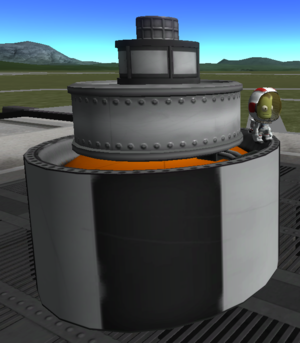Difference between revisions of "Radial size"
(+image;) |
|||
| Line 1: | Line 1: | ||
[[File:Radial size comparison.png|thumb|A comparison between the radial sizes. From top to bottom: Tiny, small and large]] | [[File:Radial size comparison.png|thumb|A comparison between the radial sizes. From top to bottom: Tiny, small and large]] | ||
The '''radial size''' is defined as the diameter or mounting position for most parts. If the mounting position is not radially the part is either round or one of two special forms. Rectangular parts like the [[M-1x1 Structural Panel]] don't have a radial size or its a size to the next bigger diameter like the [[Probodobodyne QBE]]. There are three radial sizes existing with varying names. The size scale looks like the internal definition as the [[Mk2 to size 1 Adapter]] uses this term and starts with <tt>0</tt> and many values in computer programming are starting from 0 rather than 1. | The '''radial size''' is defined as the diameter or mounting position for most parts. If the mounting position is not radially the part is either round or one of two special forms. Rectangular parts like the [[M-1x1 Structural Panel]] don't have a radial size or its a size to the next bigger diameter like the [[Probodobodyne QBE]]. There are three radial sizes existing with varying names. The size scale looks like the internal definition as the [[Mk2 to size 1 Adapter]] uses this term and starts with <tt>0</tt> and many values in computer programming are starting from 0 rather than 1. | ||
| + | |||
| + | A radial size mismatch does not prevent a connection- any stackable part can be connected to any other stackable part. Matching radial sizes only serves to give a rocket a cleaner visual appearance, and several adapter parts exist to allow transitions between radial sizes while maintaining an unbroken surface. | ||
{| class="wikitable center" | {| class="wikitable center" | ||
| Line 28: | Line 30: | ||
| [[Rockomax "Mainsail" Liquid Engine]] | | [[Rockomax "Mainsail" Liquid Engine]] | ||
|} | |} | ||
| + | |||
As a special radial size ''{{Radial Size|r}}'' appears. Parts like [[Rockomax 24-77]] don't have any general metric counterparts so there is no confusion about them. | As a special radial size ''{{Radial Size|r}}'' appears. Parts like [[Rockomax 24-77]] don't have any general metric counterparts so there is no confusion about them. | ||
| − | + | There are also non-cylindrical sizes named "Mk1", “Mk2”, and “Mk3”, which are used by fuselage parts intended for [[spaceplane]]s. | |
Revision as of 15:43, 16 September 2013
The radial size is defined as the diameter or mounting position for most parts. If the mounting position is not radially the part is either round or one of two special forms. Rectangular parts like the M-1x1 Structural Panel don't have a radial size or its a size to the next bigger diameter like the Probodobodyne QBE. There are three radial sizes existing with varying names. The size scale looks like the internal definition as the Mk2 to size 1 Adapter uses this term and starts with 0 and many values in computer programming are starting from 0 rather than 1.
A radial size mismatch does not prevent a connection- any stackable part can be connected to any other stackable part. Matching radial sizes only serves to give a rocket a cleaner visual appearance, and several adapter parts exist to allow transitions between radial sizes while maintaining an unbroken surface.
| Name | Size scale | Meter scale | Actual size | Example |
|---|---|---|---|---|
| Tiny | 0 | 0.5 m | 0.625 m | Clamp-O-Tron Jr. |
| Small | 1 | 1 m | 1.25 m | LV-T30 Liquid Fuel Engine |
| Large | 2 | 2 m | 2.5 m | Rockomax "Mainsail" Liquid Engine |
As a special radial size Radial mounted appears. Parts like Rockomax 24-77 don't have any general metric counterparts so there is no confusion about them.
There are also non-cylindrical sizes named "Mk1", “Mk2”, and “Mk3”, which are used by fuselage parts intended for spaceplanes.
